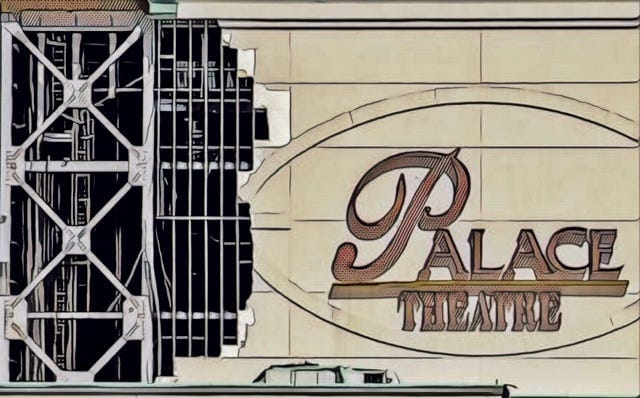Hasty Decision to Demolish the Palace Theatre represents a Failure of the Imagination
MYRTLE BEACH, SC — After sitting in disrepair for months, the land owners have decided to demolish the 2,700-seat Palace Theatre, rather…

MYRTLE BEACH, SC — After sitting in disrepair for months, the land owners have decided to demolish the 2,700-seat Palace Theatre, rather than make the investments to repair the building. The property’s owner, Chapin Company, cites mildew damage to the interior as a result of weather exposure due to unrepaired large gaps in the exterior wall that occurred when Hurricane Matthew tore through the region in late September-early October of last year.
Rather than demolish the building, Chapin Company should take the time to explore their financial options for the sale, transfer or lease of the property in a public-private partnership in light of the City’s ambition to develop a new performing arts center for Myrtle Beach.
There is little doubt that the Palace Theatre property has the physical capacity to meet the community’s long-sought site requirements for the performing arts, as well as addressing other arts and cultural space needs that could add cultural tourism to the region’s other draws.
The City of Myrtle Beach is reviewing plans for a new $9.8 million Performing Art Center and Amphitheatre. It seems appropriate to test the various options on how the Palace Theatre, if repaired and upgraded, can serve the visual arts, cultural and performing arts needs of the region. Such a plan would comply with the Cultural Resources element of the Horry County’s Comprehensive Plan (page CR 32) that states that the County should “encourage the reuse and redevelopment of existing structures over new construction to maintain existing cultural entrenchment of structures.”
Public-private partnerships are long-term, performance-based arrangements and they are most suitable when public partners, such as the City of Myrtle Beach and private entities like, Chapin Company, can forge a mutually beneficial agreement to work toward a common aim. Creatively reusing the existing Palace Theatre building, one of the two original buildings at Broadway at the Beach when it opened on July 4, 1995, can achieve a success that neither entity can attain separately.
Further, public-private partnerships provide for the involvement of other stakeholders such as non-profits, private foundations, state and federal agencies as well as the private sector in the form of grants, investments, sponsorships, and donations. In these arrangements, there are financial tools that the private sector can bring to create value. The city and other area non-profit partners can provide access to public incentives, such as tax increment financing and tax credits that make the redevelopment opportunity more viable for private investors.
Such an approach will connect cultural tourism and the marketing of a new cultural facility to the broader context of economic development through destination marketing by the Myrtle Beach Area Convention and Visitors Bureau and the Myrtle Beach Area Chamber of Commerce. In this way, cultural tourism becomes a revitalization initiative for Horry County that attracts key groups to the Grand Strand and establishes a new art and cultural hub of economic activity for the region. This approach opens up new financial incentives.
While the efforts to build a new performing arts center and amphitheater in Myrtle Beach are well underway and the committee has already selected an architect, the Myrtle Beach City Council has not made a commitment to fund the project. This is an opportunity to the reassess financial considerations already on the table.
It is possible that the Chapin Company has other redevelopment plans for the Palace Theatre site, however, there are significant costs associated with the demolition of the current structure and likewise, there are significant costs associated with developing a new performing arts center in Myrtle Beach. These expenses need to re-evaluated in light of the abundance of financial incentives available by working together toward a shared vision.
One such successful South Carolina partnership is the renovation of the Newberry Opera House, a $6 million- project that transformed a neglected, city-owned, historic building to a center for the performing and visual arts that serves the community and attracts cultural tourism.
Today the Newberry Opera House is a high-quality performance space that brings in recognized performers and attracts regional audiences as a cultural tourism destination. Their facility includes public areas, support spaces, specialized theatrical lighting and sound systems as well as exhibition spaces for visual artists. The Opera House’s public spaces can accommodate a variety of events and they feature a fully-equipped catering kitchen.
Imagine how repairs and upgrades to the Palace Theatre could serve the arts and cultural needs of the region, as well as the City of Myrtle Beach. The Palace Theatre has served the Grand Strand as a performing arts venue more than 20 years and much of the necessary infrastructure and equipment is already in place. The location is already a well-known and well-respected destination for cultural tourism.
It would be a shame to tear the Palace Theatre down without examining the financial alternatives. I hope all parties will come to the table to investigate the value that the property can provide Horry County.
Dr. Dennis Stevens is the president and founder of Conway Cultural Development Corporation, an Horry County-based non-profit that uses creative placemaking to revitalize communities by designing, developing, and implementing public projects that link arts, cultural and heritage strategies to education, economic development, and urban planning and design.



